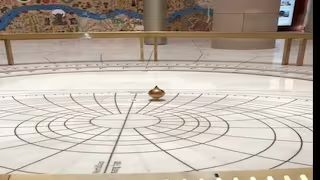Foucault Pendulum | 01 Jun 2023
Why in News?
India's newly inaugurated Parliament building showcases a remarkable piece of scientific artistry suspended from its ceiling - a Foucault pendulum.
- Foucault’s pendulum in the New Parliament building also represents the spirit of scientific inquiry and scientific temper which is enshrined in the Article 51A of the Indian Constitution.
What is a Foucault Pendulum?
- A Foucault pendulum, named after the 19th century French physicist Leon Foucault, is a simple experiment to demonstrate the Earth’s rotation.
- It consists of a heavy object hung from a long wire, free to swing in any direction. When set in to-and-fro motion, the pendulum appears to change its orientation slowly over time, due to the relative motion between the pendulum and the rotating Earth.
- Foucault first performed this experiment publicly in 1851 at the Pantheon in Paris, where he suspended a 28-kg iron ball from a 67-m wire. It was the first direct visual evidence of the Earth’s rotation.
- The experiment concluded that “pendulum does not change its plane of motion, but the ground beneath it does.”
- When aligned along the Earth's axis at the north and south poles, the pendulum’s back-and-forth motion comes back to its original plane in exactly 24 hours.
- At other latitudes, it takes longer for the pendulum to return to its original orientation of swinging. That is because the pendulum is not aligned with the axis of rotation of the earth.
- The rate and direction of the pendulum’s apparent rotation depend on its latitude.
- At the North Pole, it would complete one clockwise rotation in 24 hours.
- At the equator, it would not rotate at all.
- At other latitudes, it would rotate at intermediate rates and directions.
What is Special about the Pendulum in the New Parliament Building?
- The pendulum in the new Parliament building was created by the National Council of Science Museum (NCSM) in Kolkata.
- It is said to be the largest such piece in India, with a height of 22m and a weight of 36 kg.
- The pendulum hangs from a skylight at the top of the Constitution Hall, and signifies the “integration of the idea of India with the idea of the cosmos”.
- At the latitude of Parliament, New Delhi (28.6° N), it takes about 49 hours and 59 minutes for the pendulum to complete one clockwise rotation.

